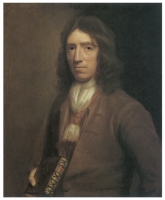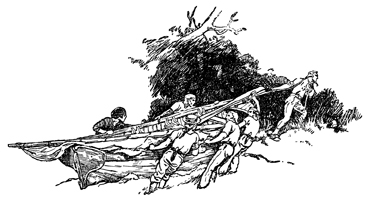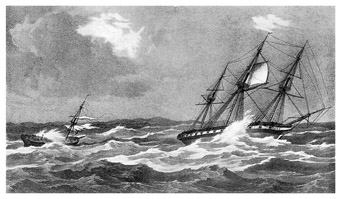
John Julian - The Teenage Pirate
| View previous topic :: View next topic |
| Author |
Message |
Salty Dog

Sailing Master 
Posts: 10060 



191991 Gold -

|
 Posted: Fri Sep 15, 2017 9:20 pm Post subject: John Julian - The Teenage Pirate Posted: Fri Sep 15, 2017 9:20 pm Post subject: John Julian - The Teenage Pirate |
 |
|
By Laura Nelson
There are only two known survivors of the April 1717 wreck of the Whydah, commanded by Sam Bellamy: Thomas Davis, a carpenter, and John Julian, a pilot.1 Although the majority of historical records list John as a Cape Cod Indian, further research by the team recovering artifacts from the wreck site reveals that he was actually a Miskito Indian from the region of Nicaragua and Honduras in Central America called the Costa de Miskitos (the Mosquito Coast).
John was probably around 16 years old when he became the Whydah's pilot and guided it in and out of hidden harbors through the difficult waters of Cape Cod.” (Clifford, Real, 81)

According to William Dampier, who interacted with the Miskito Indians circa 1687, “They are tall, well made, raw-boned, lusty, strong, and nimble of foot; long visaged, lank black hair, look stern, hard favour’d, and of a dark Copper-colour Complexion. . . . Their chiefest employment in their own Country is to strike Fish, Turtle, or Manatee . . . . For this they are esteemed and coveted by all Privateers; for one or two of them in a Ship will maintain 100 men: So that when we careen our Ships, we choose commonly such places where there is plenty of Turtle or Manatee for these Moskito Men to strike: and it is very rare to find Privateers destitute of one or more of them, when the Commander, or most of the Men are English . . . .” (Dampier, 7- |
|
| Back to top |
|
 |
Salty Dog

Sailing Master 
Posts: 10060 



191991 Gold -

|
 Posted: Fri Sep 15, 2017 9:21 pm Post subject: Posted: Fri Sep 15, 2017 9:21 pm Post subject: |
 |
|
In addition to their fishing skills, Dampier also wrote, “They are very ingenious at throwing the Lance, Fisgig, Harpoon, or any manner of Dart.”2 (Dampier, 7) He then goes on to comment that “. . . they often come with the Seamen.” (Dampier, 10)
Colin Woodard in his book The Republic of Pirates states that John “had served with Bellamy aboard his periaguas.”3 (Woodard, 185) While there is no specific record of how John joined Sam Bellamy's crew, in March 1715, Bellamy was with a band of pirates that operated in the Bay of Honduras, the region where the Miskito Indians lived.

Example of periagua
It was fairly common that when a pirate crew captured a slave ship still carrying its cargo, many slaves, once freed, joined the pirates.4 Even if they lacked skills as seamen, they often had martial skills that made them valuable to their new crews. Many learned sailing skills after joining the pirates. “Blacks received shares of booty and enjoyed other perquisites of crew membership, including the right to vote. Rewards and incentives appear to have been based on an individual's ability to function effectively within the pirate crew rather than on skin color.” (Kinkor, 200) |
|
| Back to top |
|
 |
Salty Dog

Sailing Master 
Posts: 10060 



191991 Gold -

|
 Posted: Fri Sep 15, 2017 9:22 pm Post subject: Posted: Fri Sep 15, 2017 9:22 pm Post subject: |
 |
|
Black men were well represented amongst pirate crews.
*Blackbeard's crew was 60 percent black;
*Edward England's crew of 300 included about 80 black pirates;
*Half of John Lewis's crew of 80 were black men from English colonies;
*On his last voyage, Christopher Condent's crew of some 500 pirates included an estimated 200 black men;
*Bart Roberts's crew included 70 black men out of a total of 267; and
*Two pirate crews, the names of their commanders unknown, were almost 100 percent black. (Clifford, Real, 80)
According to A General History of the Pyrates, when Captain Olivier Le Vasseur (also known as La Buse, the Buzzard) met up with Howell Davis off the coast of Gambia, half of his crew were blacks. |
|
| Back to top |
|
 |
Salty Dog

Sailing Master 
Posts: 10060 



191991 Gold -

|
 Posted: Fri Sep 15, 2017 9:23 pm Post subject: Posted: Fri Sep 15, 2017 9:23 pm Post subject: |
 |
|
While sailing with Bellamy, John may have traveled to such places as the Gulf of Cuba; Honduras; Portobello in Panama; Baya Honda, Cuba; Cape Corientes and the Isle of Pines in Puerto Rico; the north coast of Haiti; St. Criox; and La Isla Blanquilla in Venezuela. Along the way he participated in capturing and plundering ships and experienced what it meant to dress in fine clothes and have a pocket full of money. He also rose to the position of pilot, making him responsible for guiding the pirate ships in and out of hidden harbors to escape the authorities.
April 26, 1717, started out like any other day for the pirates. In the morning, they captured the Mary Anne, “a pink with more than 7,000 gallons of Madeira wine on board . . . and the Fisher – a small sloop with a cargo of deer hides and tobacco, captured that afternoon.” (Clifford, Real, 130) John remained on the Whydah that day, having not been sent over to the Fisher or the Mary Anne as part of their prize crews.
In the evening a storm began to roll in, heralded by a dense fog.5 “According to eyewitness accounts, gusts topped 70 miles [113 kilometers] an hour and the seas rose to 30 feet [9 meters].6 The accident was best expressed by Thomas Davis in his deposition before his trial:
The Ship being at an Anchor, they cut their Cables and ran a shoar, in a quarter of an hour after the Ship struck, the Main-mast was carried by the board, and in the Morning She was beat to pieces. About Sixteen Prisoners drown'd, Crumpstey Master of the Pink being one, and One hundred and forty-four in all. (Trials, 318)
 |
|
| Back to top |
|
 |
Salty Dog

Sailing Master 
Posts: 10060 



191991 Gold -

|
 Posted: Fri Sep 15, 2017 9:23 pm Post subject: Posted: Fri Sep 15, 2017 9:23 pm Post subject: |
 |
|
“Although the beach was just 500 feet away, the bitter ocean temperatures were cold enough to kill the strongest swimmer within minutes. Other crew members were crushed by the weight of falling rigging, cannon, and cargo as the ship, her treasure, and the remaining men on board plunged to the ocean floor, swallowed up by the shifting sands of the cape.” (Clifford, Real, 131)
When local residents arrived on the shore the next morning “more than a hundred mutilated corpses lay at the wrack line with the ship's timbers.”7
Yet somehow John Julian and Thomas Davis managed to reach the shore, and then climb the steep sand cliffs of what is now called Marconi Beach. While Thomas “found temporary refuge in the home of Cape Cod locals Samuel Harding and his wife,” there is no historical record telling where John was. (Clifford, Real, 131). They suddenly reappear as part of a group of nine pirates who were arrested and taken on horseback to Boston Gaol a day or so after the wreck. The other seven pirates were survivors from the prize ship Mary Anne: Hendrick Quintor, Thomas South, Peter Cornelius Hoof, John Shuan, John Brown, Thomas Baker, and Simon Van Vorst.
But unlike his comrades, John did not stand trial for piracy. According to National Geographic’s Pirates of the Whydah, “[h]e was probably the Julian the Indian bought by John Quincy – whose grandson, President John Quincy Adams, became a staunch abolitionist.”8 |
|
| Back to top |
|
 |
Salty Dog

Sailing Master 
Posts: 10060 



191991 Gold -

|
 Posted: Fri Sep 15, 2017 9:24 pm Post subject: Posted: Fri Sep 15, 2017 9:24 pm Post subject: |
 |
|
If John Julian and Julian the Indian were the same person, he suffered. “A purportedly ‘unruly slave,’ Julian the Indian was sold to another owner and tried often to escape. During one attempt he killed a bounty hunter who was trying to catch him.”9
The Massachusetts Historical Society's website has an online presentation entitled “African Americans and the End of Slavery in Massachusetts.” One article, “The Lives of Individual African Americans before 1783,” notes that:
Slaves in Massachusetts usually lived with their owners, and had more direct contact with family members than the way of life we associate with plantation slavery in the West Indies and later in the American south. The Massachusetts courts recognized the right of slaves to hold and dispose of some property, to keep wages for work done not on their masters’ time, to bring suit in court, and the right to jury trials, legal counsel, and some legal protection. . . .
Daily life of African Americans was controlled through legislation. A 1703 law forbade blacks, Native Americans, and mulattos from venturing out after 9:00 pm, unless on a master's errand. . . . “Unruly” slaves could be punished by the law . . . .10
Ultimately, the law did catch up to John. A pithy paragraph in The Weekly Rehearsal, a Boston newspaper published in March 1733, says:
Thursday next is the Day appointed for the Execution of Julian the Indian. He went Yesterday both Forenoon and Afternoon to hear the Rev. Mr. Checkley, who had prepared two Discourses suitable to the Occasion. The Rev. Ministers of the Town have taken a great deal of Pains with the unhappy Criminal, to prepare him for his approaching Change, and 'tis hoped their Labours have not been in vain |
|
| Back to top |
|
 |
Salty Dog

Sailing Master 
Posts: 10060 



191991 Gold -

|
 Posted: Fri Sep 15, 2017 9:25 pm Post subject: Posted: Fri Sep 15, 2017 9:25 pm Post subject: |
 |
|
Elizabeth Moisan, in Master of the Sweet Trade, wrote, “It was common for the unclaimed bodies of executed prisoners to be given to medical students for dissection, and according to an article in The Boston News-letter, on March 30, 1733 John’s corpse was used for this purpose. The article goes on to tell us that, ‘The Bones are preserv’d in order to be fram’d into a Skeleton.’” A sad end for such a young man.
Notes:
1. “Whydah” (pronounced whih-dah) derives from the African kingdom of Ouidah, which developed into a major center for the exportation of slaves. Located in the Republic of Bénin, the Ouidah Museum of History introduces visitors to the town’s history and involvement in the slave trade.
2. According to D. Smith’s A Voyage to Constantinople (1668), the fisgig was “a kind of barbed iron at the end of a pole tyed fast to a rope.” It was used to spear fish.
3. Based in the Bay of Honduras in March 1716, Bellamy and his men sailed aboard two periaguas. These canoes were “capable of carrying thirty men and an ample supply of cargo. Equipped with banks of oars and a single fore-and-aft rigged sail, they were well suited to small-scale piracy: swift, able to row straight into the wind to catch or escape from a square-rigged vessel, and drawing so little water they could be rowed or sailed over shoals, coral heads, and other hazards to give would-be pursuers the slip.” (Woodard, 89) The periagua was often the first vessel pirates acquired; thereafter, they would capture bigger and bigger vessels. |
|
| Back to top |
|
 |
Salty Dog

Sailing Master 
Posts: 10060 



191991 Gold -

|
 Posted: Fri Sep 15, 2017 9:25 pm Post subject: Posted: Fri Sep 15, 2017 9:25 pm Post subject: |
 |
|
4. Many pirate histories say the opposite of this statement. Ken Kinkor, in “Black Men under the Black Flag,” disputes this. “Although seventy blacks were as active as any among Bart Roberts’s crew, they were delivered to the Royal African Company in 1722 without trial. . . . In 1724 captured black pirates were likewise sold in lieu of trial. These were, however, minority opinions. In trial after trail, blacks were placed on the same legal footing as whites. They comprise an undetermined percentage of an estimated four hundred pirates executed during the decade 1716-1726. Most went silently to the gallows . . . .” (Bandits, 204)
5. In Real Pirates, Barry Clifford describes the storm: “An Arctic gale from Canada was colliding with a warm front moving northward from the Caribbean. Their confluence produced one of the worst storms ever to strike Cape Cod.” (130) “Technically known as an occluded front, the warm and moist tropical air is driven for miles upward where it cools and falls at a very high speed, producing high winds, heavy rain, and severe lightning.” (Clifford, 262)
6. Donovan Webster, “Pirates of the Whydah” in National Geographic Magazine (May 1999).
7. Ibid.
8. “John Julian – Only Free at Sea” at Pirates of the Whydah, National Geographic. In February 1839, John Quincy Adams successfully represented the slaves from the Amistad. More information about this case can be read at the National Archives website.
9. Ibid.
10. “The Lives of Individual African Americans before 1783” at Massachusetts Historical Society.
For more information, Laura recommends:
Clifford, Barry. Expedition Whydah: The Story of the World's First Excavation of a Pirate Treasure Ship and the Man Who Found Her. Cliff Street Books, 1999.
Clifford, Barry, and Kenneth J. Kinkor. Real Pirates: The Untold Story of the Whydah from Slave Ship to Pirate Ship. National Geographic, 2007.
Dampier, William. A New Voyage Round the World. Printed for James Knapton at the Crown in St. Paul's Churchyard, MDCXCIX.
Defoe, Daniel. A General History of the Pyrates edited by Manuel Schonhorn. Dover, 1972.
Dethlefsen, Edwin. Whidah: Cape Cod's Mystery Treasure Ship. Seafarer’s Heritage Library, 1984.
Kinkor, Kenneth J. “Black Men under the Black Flag” in Bandits at Sea: A Pirate Reader edited by C. R. Pennell. New York University, 2001.
Moisan, Elizabeth. Master of the Sweet Trade: A Story of the Pirate Samuel Bellamy, Mariah Hallett, and the Whydah . iUniverse, 2009.
“The Trials of Eight Persons Indicted for Piracy” in British Piracy in the Golden Age edited by Joel H. Baer (2:289-319). Pickering and Chatto, 2007.
Woodard, Colin. The Republic of Pirates: Being the True and Surprising Story of the Caribbean Pirates and the Man Who Brought Them Down. Harcourt, 2007. |
|
| Back to top |
|
 |
|
|
You cannot post new topics in this forum
You cannot reply to topics in this forum
You cannot edit your posts in this forum
You cannot delete your posts in this forum
You cannot vote in polls in this forum
|
Powered by phpBB © 2001, 2005 phpBB Group |
|















